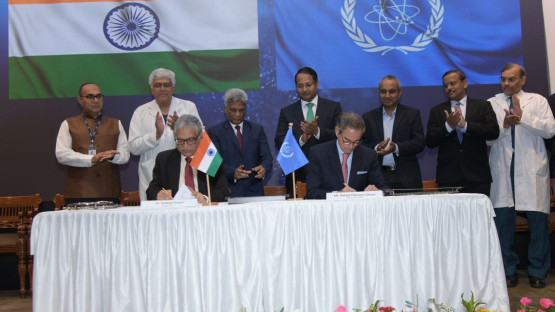The IAEA designated Tata Memorial Centre in Mumbai, India, as its newest Rays of Hope Anchor Centre during Director General Rafael Mariano Grossi’s visit to the country in March. It joins eleven other Anchor Centres worldwide, including five in the Asia-Pacific region, in serving as a hub for knowledge-sharing and capacity-building under the IAEA’s Rays of Hope initiative, which aims to expand access to cancer care where it is needed most.
“The IAEA has long worked with Tata Memorial Hospital to expand access to life-saving treatments,” said Mr Grossi in welcoming Tata Memorial Centre into the growing network during his visit. “I am inspired by the work being done here.”
“The designation of Tata Memorial Centre as an IAEA Rays of Hope Anchor Centre is a recognition of its contributions in advancing cancer care,” said Umesh Mahantshetty, Director of the Homi Bhabha Cancer Hospital and Research Centre, a unit of Tata Memorial Centre in Visakhapatnam, India. “As an Anchor Centre, we look forward to leveraging our experience and expertise at the forefront of affordable and comprehensive cancer care to the benefit of others.”
A collaboration of 11 public hospitals and centres that collectively serve nearly 10 per cent of India’s new cancer cases annually, Tata Memorial has a long history of cooperation with the IAEA – including in dozens of the Agency’s coordinated research projects.
- In nutrition, Tata Memorial helped design a project applying nuclear nutrition techniques to improve outcomes for childhood cancer in low- and middle-income countries (LMICs).
- In radiation oncology, it contributed to an implementation study on image-guided brachytherapy for cervical cancer and in the largest clinical trial of its kind on a resource-sparing treatment for head and neck cancers in LMICs.
- In nuclear medicine and diagnostic imaging, its research on lymphoma – including standardizing criteria for interpreting PET/CT images for paediatric and non-Hodgkin’s lymphoma across diverse populations using the radiopharmaceutical 18F-FDG – helped shape clinical practice.
- In medical physics, its participation enabled the successful testing of the first-ever international code of practice on the dosimetry of small static fields used in external beam radiotherapy.








